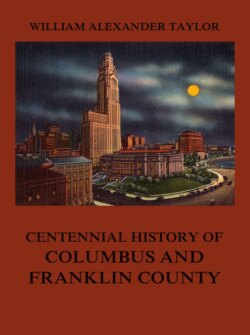Читать книгу Centennial History of Columbus and Franklin County - William Alexander Taylor - Страница 23
THE PROTESTANT EPISCOPAL CHURCH
ОглавлениеOrganized 1817.
Trinity Church—The first Protestant Episcopal church in Columbus was organized by Bishop Philander Chase, of Worthington, in the spring of 1817.
The first religious services of the denomination were held in the Buckeye House, on Broad street, by Bishop Chase on Sunday, May 3, 1817. On the 7th of that month a second service was held by Dr. Chase, and at this meeting the formal organization was entered upon and articles of association were drawn up and signed, under the style of "The Parish of Trinity Church, Columbus, State of Ohio, in connection with the Protestant Episcopal Church of the United States of America."
These articles were then duly signed by the following persons: Orris Parish, Joel Buttles, Benjamin Gardiner, Alfred Upson, Philo H. Olmsted, John Kilbourne, John Warner, Thomas Johnson, John Webster, George W. Williams, Cyrus Fay, Charles V. Kickox, John Callitt, Amasa Delano, Silas Williams, Christopher Ripley, Austin Goodrich, Daniel Smith, Josiah Sabin, Cyrus Allen, Abner Lord, James K. Carey, John C. Broderick, James Pearce, M. Matthews, William K. Lampson, Cyrus Parker, William Rockwell, A. J. McDowell, Jr., and Lyne Starling.
On the 11th day of the same month Dr. Chase held another service, at the conclusion of which the constitution of the Protestant Episcopal Church of the United States was read and adopted by the parishioners, and Trinity was thus formally organized. Church officers were chosen as follows and entered upon their duties: Wardens, Orris Parish and Benjamin Gardiner; vestrymen, John Kilbourne and Joel Buttles; secretary, Joel Buttles. Messrs. Gardiner and Buttles were appointed delegates to the diocesan convention to be held in Columbus on the first Monday of January, 1818.
The services were held at various places pending the erection of a church building. Bishop Chase and other clergy, when opportunity offered, ministered to the church, but not until .1829 was there a regular pastor.
Beginning with that year, Rev. William Preston took charge of Trinity, in connection with St. John's of Worthington. Pending this event the church depended mainly on lay readers, among whom were Benjamin Gardiner, Cyrus Fay and Matthew Matthews. Since 1820. however, the church has been supplied with rectors, many of whom rank high in the Episcopal clergy of the nation.
The first confirmation taking place in the church was on September 15, 1830. Bishop Chase officiating. The second confirmation took place in 1833. For many years prior to 1833 the meetings of the congregation were held in a frame edifice on Third street. During the pastorate of Dr. Preston the original Trinity church was built on East Broad, where the Clinton-Hayden Bank building now stands. The lot cost one thousand dollars and the building ten thousand dollars. At that date it was the costliest church edifice in Ohio.
In 1855 an effort was. made to erect a new church, and the present high school lot was purchased for eight thousand dollars and a foundation partly laid. In 1802 work ceased and the property was sold and used for other purposes. In 1862 the present site, corner of Third and Broad streets, was purchased from Governor William Dennison, Jr.. for seven thousand five hundred dollars, and here the foundations of the present stately Trinity were laid in 1866. under the directions and supervision of William A. Piatt. Francis Collins and William G. Deshler. William Lloyd, of Detroit, was architect and Mr. Fish the superintendent of construction. The style of architecture is Gothic-English. The stone for the walls of the church was brought from Licking county. The total cost of the structure approximated seventy thousand dollars. The chapel was available for regular services in 1868. The main auditorium was finished in 1869. Trinity Guild, to promote the interests of Trinity Church, was organized November 6, 1872. The Trinity Chapter, No. 115, of the Brotherhood of St. Andrew, was organized in 1891-92.
The property on the north side of East Broad street, nearly opposite Trinity church, originally known as the Esther Institute, later as the Irving House, is now the Trinity House, having been acquired for the use of the church in 1890, the price paid for the lot and building being forty-five thousand dollars. One of the notable events at Trinity was the consecration of Bishop Kendrick, January 18. 1889, in the presence of a vast audience.
St. Paul's—In 1841-42 St. Paul's church was erected at the corner of Mound and Third streets. At a meeting of the signatories of the articles of association, December 7, 1842, Rev. H. L. Richards, the first rector of the church, presided and F. J. Matthews acted as secretary. A. Buttles was chosen senior warden; I. N. Whiting, junior warden; and Henry Matthews, Moses Altman, John Burr and Herman H. Hubbard, vestrymen. Growth of membership and desirability of environment led to the change of location of the church edifice at or near the turn of the century, and St. Paul's church is now located on the south side of East Broad, between Garfield and Monroe avenues.
Church of the Good Shepherd, located on the southeast corner of Buttles and Park avenue, was originally built as and intended for a mission of Trinity Episcopal congregation. The corner stone of the church edifice was laid June 13, 1871, with the usual ceremonies, conducted by Bishop Bedell of Gambier. On that occasion a notable address was delivered by Rev. Wyllys Hall. The first rector of the church was Rev. Frederick Grannis.
Church Edifices and Locations.
Trinity: Southeast corner Broad and Third streets. Rev. Theodore Irving Reese.
St. Paul's: East Broad street, between Garfield and Monroe avenue.
Good Shepherd: Southeast corner Buttles and Park.
Missions of Trinity.
All Saints' (for deaf and dumb): 136 East Broad Street, St. John's Chapel: Southwest corner Avondale and Town. Rev. Robert Johnston.
St. Philip's ( colored): Lexington, between McKinnon and Spring.
Rev. R. D. Brown. Branch at 961-2 Mt, Vernon.
